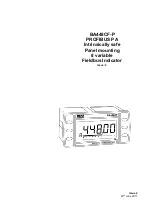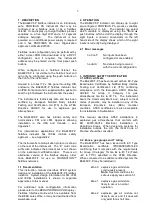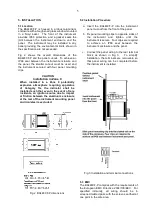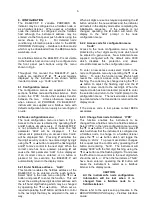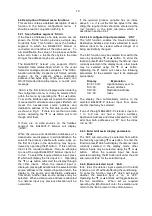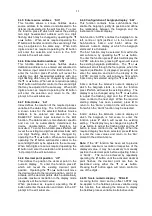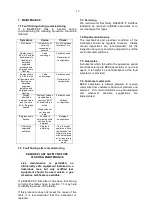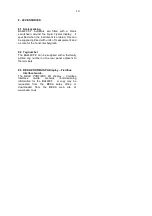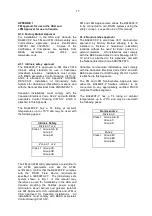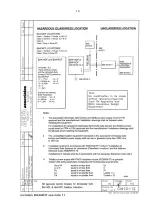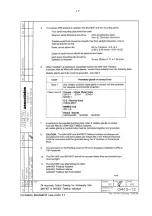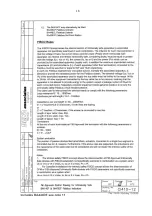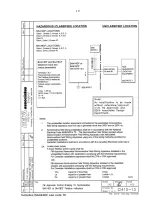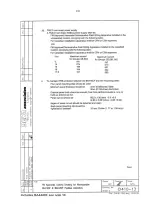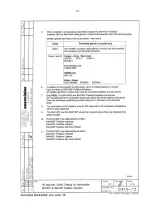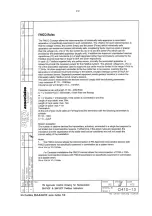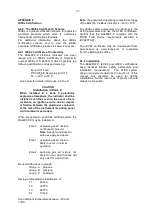
11
6.4.5 Enter source address ‘SrC’
This function allows a known fieldbus device
source address to be entered and allocated to the
listener input selected in the edit function. To enter
the function press P which will reveal the existing
two digit hexadecimal address with one digit
flashing which may be changed by operating the
▼
or
▲
button. When set as required operating the
P button will transfer control to the second digit that
may be adjusted in the same way. When both
digits are set as required operating the E button
will enter the selection and return to the ‘SrC’
prompt in the edit sub-menu.
6.4.6 Enter destination address ‘dSt’
This function allows a known fieldbus device
destination address to be entered and allocated to
the listener input selected in the Edit function. To
enter the function press P which will reveal the
existing two digit hexadecimal address with one
digit flashing which may be changed by operating
the
▼
or
▲
button. When set as required operating
the P button will transfer control to the second digit
that may be adjusted in the same way. When both
digits are set as required operating the E button
will enter the selection and return to the ‘dSt’
prompt in the edit sub-menu.
6.4.7 Enter Index ‘ind’
Index defines the location of the required process
variable in the data string. The ‘ind’ function allows
a known Index for the selected fieldbus Source
Address to be entered and allocated to the
BA448CF-P listener input selected in the Edit
function. The data location is manufacturer specific
and can not be automatically determined; the
device
documentation
should
therefore
be
consulted. To enter the function press P which will
reveal the existing two digit hexadecimal Index with
one digit flashing which may be changed by
operating the
▼
or
▲
button. When set as required
operating the P button will transfer control to the
second digit that may be adjusted in the same way.
When both digits are set as required operating the
E button will enter the selection and return to the
‘ind’ prompt in the edit sub-menu.
6.4.8 Decimal point position ‘dP’
This defines the position the decimal point in the
numeric display. To enter the function press P
which will reveal the existing decimal point
position. Operating the
▼
or
▲
button will move
the decimal point to the required position, omit it, or
activate all the decimal points which automatically
provides maximum resolution in the display mode
irrespective of the numeric value.
When positioned as required, operating the E
button will enter the selection and return to the ‘dP’
prompt in the edit sub-menu.
6.4.9 Configuration of bargraph display ‘bAr’
This function contains three sub-functions that
enable the bargraph, justify its position and define
the relationship between the bargraph and the
instrument’s numeric display.
Sub-function ‘b.tYPE’ enables the bargraph to be
left, centre or right justified, or to be turned off.
Sub-functions ‘bArLo’ and ‘bArhi’ define the
listener’s numeric display at which the bargraph
starts and is at full scale.
The ‘bAr’ function may be selected from within the
edit sub-menu by operating the
▼
or
▲
button.
To enter the function press P which will display the
‘b.tYPE’ sub-function, pressing P again will reveal
the existing bargraph justification. The
▼
or
▲
button will scroll through the four options, when the
required justification is displayed, pressing E will
enter the selection and return the display to the
‘b.tYPE’ prompt in the edit sub-menu from which
‘bArLo’ may be selected using the
▼
or
▲
button.
‘bArLo’ defines the listener’s numeric display at
which the bargraph starts, to enter the function
press P which will reveal the existing setting. The
display may be changed using the
▼
or
▲
button
to adjust the flashing digit and the P button to
move control to the next digit. When the required
starting display has been selected, press E to
return to the ‘bArLo’ prompt in the edit sub-menu
from which the ‘bArHi’ function may be selected.
‘bArHi’ defines the listener’s numeric display at
which the bargraph is full scale, to enter the
function press P which will reveal the existing
setting. The display may be changed using the
▼
or
▲
button to adjust the flashing digit and the P
button to move control to the next digit. When the
required display has been selected, press E twice
to enter the new values and return to the ‘bAr’
prompt in the edit sub-menu.
Note: If the ‘dP’ function has been set to provide
automatic maximum resolution irrespective of the
displayed value, it may be necessary to manually
position the decimal point before adjusting ‘bArLo’
or ‘bArHi’. This can be achieved by repeatedly
operating the P button until the activated decimal
point flashes, the decimal point can then be
positioned using either the
▼
or
▲
button.
Pressing the P button again will return control to
one of the digits.
6.4.10 Scale numeric display ‘SCALE’
A scaling factor ‘Gain’ and an offset ‘oFFSt’ may
be applied to the fieldbus process variable using
this function, thus allowing the listener to display
the fieldbus process variable in alternative units.



